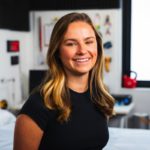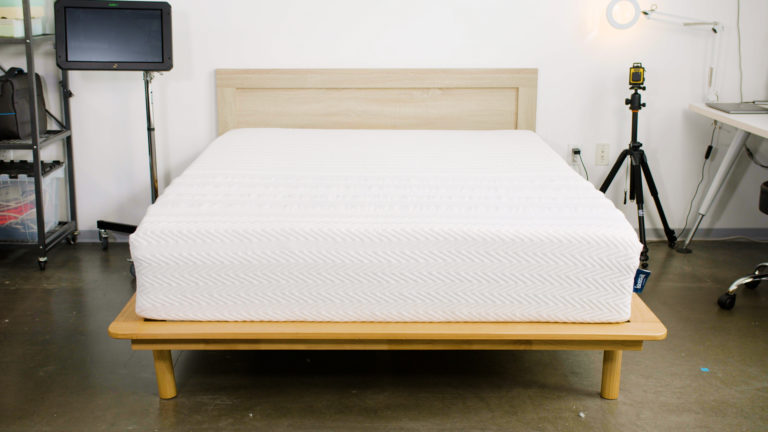When you buy through our links, we may earn a commission. Products or services may be offered by an affiliated entity. Learn more.
Bear Original vs. Leesa Original Mattress Comparison

Bear Original
Bottom Line
The ultra-supportive Bear Original offers more support and responsiveness than most competing all-foam models.
40% sitewide with code: SF40
Full Mattress ReviewVS

Leesa Original
Bottom Line
The mixed-foam Leesa Original delivers a soothing balance of cushioning, support, bounce, and breathability.
25% off sitewide
Full Mattress ReviewShoppers looking for a US-made all-foam mattress will likely come across the Bear Original and Leesa Original at some point. Both brands were early participants in the “mattress in a box” movement — Bear in 2014 and Leesa in 2015 — and both are now owned by 3Z Brands, a company that also owns Brooklyn Bedding, Helix Sleep, and Birch.
The Bear Original and Leesa Original mattresses are both all-foam models sold at comparable prices, which may make choosing between them feel difficult. For that reason, we brought both beds into our Seattle-based Test Lab and also had our testing team members take them home to try them out. Additionally, we compared their companies’ policies and combed through online customer reviews to help you figure out which one you may prefer.
Quick Look
$649 – $1,373
$639 – $2,079
Medium Firm (6), Firm (7)
Medium (5), Medium Firm (6)
- Specialty Celliant cover uses infrared energy to enhance nightly recovery.
- Thoughtful layering of materials provides dynamic performance from all-foam and hybrid options.
- Quality mattress options at affordable prices.
- Blend of contouring and bounce for well-balanced performance.
- Multi-layered comfort systems for improved pressure relief.
- Eco-friendly cover that is made with recycled plastics (Leesa Legend).
- B-Corporation with demonstrated commitment to social causes.
- 120 nights (30-night break-in period)
- Lifetime, limited
- 120 nights (30-night requirement)
- Lifetime, limited
- Not accredited
- A+
Our Testing Team’s Take
Over the past decade, our testing team has evaluated nearly 2,000 mattresses in our Seattle Test Lab. Through this hands-on testing, we’ve developed a unique product research methodology that forms the backbone of our mattress rating system.
Using cutting-edge technology, we pressure map each bed to identify where pressure points may form. We use similarly advanced tools to measure motion transfer across each mattress’ surface and heat retention.
We also have testing team members take mattresses home for weeks at a time, allowing them to mimic real-world use. Because our team members represent a variety of body weights and sleep position preferences, their perspectives can help you identify which might be the best mattress for you.
Our Verdict
Although the Bear Original and the Leesa Original are both all-foam mattresses, they appeal to different types of sleepers and excel in different areas due to their differing firmness levels. The Bear Original is firm (7), while the Leesa Original is medium (5). Their firmness levels are the biggest distinguisher and likely the reason most shoppers will choose one over the other.
Side and back sleepers weighing between 130 and 230 pounds find the most comfort and support on the Bear Original. The Leesa Original works well for side sleepers under 230 pounds and back sleepers under 130 pounds. Stomach sleepers tend not to prefer either model.

Jeremy Klein
Senior Product Testing Manager
Side sleeper
160 pounds
Nightly melatonin user
“The Bear Original mattress was easy to move around and set up as it is very light in comparison to other mattresses. The Bear felt firmer overall, so as a side sleeper who likes beds a little softer, I didn’t fall in love with it. Back sleeping on the other hand was fantastic.”
Both mattresses isolate motion well, which is common for all-foam beds. The Leesa Original excels at relieving pressure, which is also common for all-foam beds. But, because of the Bear Original’s firmness level, it doesn’t provide quite as much pressure relief.

Logan Foley
Editorial Director
Side sleeper
140 pounds
Has too many dogs in the bed
“I found the Leesa Original to be very supportive for side sleeping. On top of that, I thought the motion isolation was great. My only real concern with this mattress was that it felt somewhat unstable around the edges.”
Construction and Materials
The Bear Original and Leesa Original are all-foam beds with similar materials, but they do have slight differences in construction.
| Construction Analysis | Bear Original | Leesa Original |
|---|---|---|
| Cover | Quilted fabric with optional Celliant-infused cover | 87% polyester, 13% viscose |
| Comfort Layer | Memory foam (gel-infused) | 2″ polyfoam |
| Transitional Layer | Polyfoam | 2″ memory foam |
| Support Core | 7″ Polyfoam | 6″ polyfoam |
Bear Original Breakdown
The Bear Original is a firm all-foam mattress that rates 7 out of 10 on our firmness scale. This model measures 10 inches thick, which makes space for four layers. The default cover layer is quilted, and Bear offers an upgraded cover for a fee. The upgraded cover is infused with Celliant fiber, which is intended to promote muscle recovery and cooling by converting body heat into far infrared radiation.
The next layer beneath the cover is a memory foam comfort layer. While this mattress doesn’t provide a deep “hug,” this layer does lightly conform to the body. It’s also been infused with gel, which is intended to promote cooling. Beneath it, there’s a polyfoam transitional layer. This layer adds to the bed’s cushion but is firmer, so it keeps sleepers from hitting the bed’s support core.
A 7-inch layer of polyfoam makes up the Bear Original’s support core. The polyfoam in this layer is firmer and has a higher density than the transitional polyfoam layer. It provides much of the bed’s firmness and support. All of the foam in the Bear Original is CertiPUR-US certified, which indicates that it’s free from formaldehyde, mercury, lead, and a variety of potentially harmful substances, like phthalates and certain fire retardants. The mattress is also free from fiberglass.
Leesa Original Breakdown
The Leesa Original is softer than the Bear Original, clocking in as a medium (5) on our scale. With a 10-inch profile, it’s the same thickness as the Bear, and it similarly contains four layers. The cover is a blend made of polyester and viscose, and it’s been designed to promote cooling airflow.
Sitting beneath the cover is a 2-inch polyfoam comfort layer. This layer “hugs” the body and has been aerated, which means it’s had holes drilled in it to allow heat to disperse. Beneath that is a 2-inch memory foam transitional layer. This layer adds to the bed’s cushion and ability to relieve pressure.
The Leesa Original’s support core is a 6-inch thick layer of high-density polyfoam. This layer helps promote spinal alignment and contributes to the mattress’ firmness. Like the Bear Original, all of the foam in the Leesa Original is CertiPUR-US certified and free from fiberglass.
Mattress Sizing and Weight
The Bear Original and Leesa Original share identical profiles and nearly identical weights. Both can easily fit standard fitted sheets. While they weigh less than many hybrid, latex, and airbed models, many people will still want to enlist someone else to help when lifting or moving either mattress.
| Mattress Model | Profile | Weight (Queen) |
|---|---|---|
| Bear Original | 10″ | 70 lbs. |
| Leesa Original | 10″ | 71 lbs. |
Performance Ratings
Like many all-foam mattresses, the Bear Original and Leesa Original perform well at isolating motion. Foam readily absorbs motion, which can help couples who share a bed avoid disrupting each other’s sleep when one of them rolls over or gets in or out of bed at night. Also like many all-foam mattresses, the Leesa Original excels at relieving pressure. While the Bear Original does give sleepers a bit of a “hug,” it doesn’t provide quite as much pressure relief, due to its firmness.
These beds don’t rate as highly on edge support as many others do, especially hybrid models. While many sleepers won’t mind, those who like to sit or lie near the edge of the bed may not feel properly supported while doing so. Temperature control can be an issue with all-foam beds. The Leesa Original receives above-average scores in this area, while the Bear Original rates slightly below average.
Because these mattresses have different firmness levels, different types of sleepers are better suited to each one. The Leesa Original best supports side sleepers weighing less than 230 pounds and back sleepers weighing less than 130 pounds. The Bear Original best supports side and back sleepers weighing between 130 and 230 pounds.
Mattress Pricing and Policies
Overall, all-foam mattresses tend to cost less than latex, hybrid, or airbed mattresses. This difference stems from the cost of foam compared to materials like natural latex, the steel that makes up coils in hybrids, and the technology built into airbeds. Foam is synthetic and costs less to produce than most other mattress materials.
The Bear Original and Leesa Original mattress models are on the low-to-middle range of the all-foam mattress price spectrum. Though their prices are comparable, the Leesa costs a little more than the Bear. Both mattresses come with similar policies, but Bear offers a limited lifetime warranty, whereas Leesa offers a 10-year limited warranty.
| Policy | Bear Original | Leesa Original |
|---|---|---|
| Sleep Trial | 120 nights | 120 nights |
| Warranty | Limited lifetime | 10-year limited |
| Shipping | Free to the contiguous US; Alaska and Hawaii for a fee | Free to all 50 US states; for a fee to Canada |
| White Glove Delivery | Available for a fee | Available for a fee |
What Customers Are Saying
The vast majority of online customer reviews and ratings of the Beer Original and Leesa Original are positive. Reviewers frequently mention how comfortable both beds are, with many customers saying that they get great sleep on the beds. Reviewers also often call both beds high-value.
Negative reviews are uncommon, but both beds have received them. Some reviewers have complained that the Leesa Original off-gases an unpleasant odor that takes a while to dissipate. Reviewers of both mattresses have complained about firmness, with those reviewing the Bear Original tending to say it’s too firm and reviewers of the Leesa Original tending to say it’s too soft. This is a good reminder to identify the ideal mattress firmness for your unique body and sleep position preferences prior to placing an order.

Still have questions? Ask our community!
Join our Sleep Care Community — a trusted hub of product specialists, sleep health professionals, and people just like you. Whether you’re searching for the perfect mattress or need expert sleep advice, we’ve got you covered. Get personalized guidance from the experts who know sleep best.








